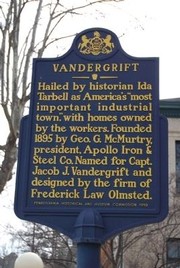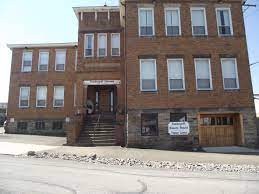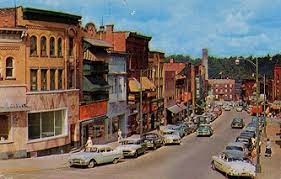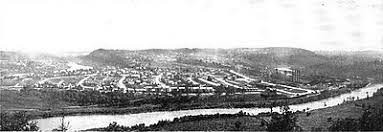Vandergrift
Introduction
Text-to-speech Audio
The city of Vandergrift was founded in 1885 by the Apollo Iron and Steel Works company. The president of the company George McMurtry had a vision to build a town strictly for the workers of the company to give them control over the workers both in the steel mill and in their homes. Apollo Iron and Steel Works had recently come out of a labor dispute with its workers and decided making the town would be the best way to prevent labor disputes from arising again. They bought 650 acres 35 miles northeast of Pittsburgh and began building a new factory and then began working on creating a town to give the workers guaranteed homes allowing for more loyal and happy workers as well as more control. The town would peak at a population of 12,000 people and today, over a century later the town remains about 80% intact of its original state.
Images

Victorian Vandergrift Museum & History Society Building

Borough of Vandergrift

The City of Vandergrift

Backstory and Context
Text-to-speech Audio
In 1990, noted historian Ida Tarbell said that Vandergrift was the most important Industrial town in America. In the late 1800s the Apollo Iron and Steel Company ran by company president George McMurtry had just ended a very bitter labor dispute by hiring replacement workers from nearby areas. The workers believed that they deserved a higher pay than what was agreed upon in a national union contract and as result they went on strike. McMurtry was one of the first industrialists that truly respected the working man. He had what was considered radical thoughts for the time with the vision for Vandergrift. He believed that the best workers were educated, churchgoing men that were able to own homes. But also because of the recent events that happened in Homestead he wanted more control over his workers not just in the factory but at all times even when they were in their own homes. The homestead strike was a violent and deadly dispute between a steel company and a lot of its workers that ended with Andrew Carnegie's reputation going down the drain. The Apollo Iron and Steel Company, as well as McMurtry watched these events unfold and wanted to find better ways to prevent these types of disputes from happening. His idea was to create a town for these workers, giving them a place to live with the hope that these happy workers would be more loyal and productive. He wanted to go above and beyond just giving out paychecks to people.
McMurtry and the company went to work trying to create his vision. He bought a 650-acre farm located a few miles downstream on the Kiskiminetas river and began building a new steelworks mill. He hired the Architectural firm Frederick Law Olmsted to design and create McMurtry's perfect town. McMurtry created an agenda focused upon popular attitudes towards the treatment of labor as well as environmentalism. The Olmsted first was able to take this set agenda and build an urban design that included social reform, comprehensive infrastructure planning and private home ownership principles. The belief that a good relationship between the steel company and the residents of this town would create loyalty among the skilled workers and hopefully bring success to the company.
The design of the town was very unique. The main feature was the curving streets. These roads followed the natural slope of the hills around the town. The town featured 14 roads and only one place where two roads intersected. There were no corners but instead they were curves. Everything needed to live in this town was installed in advance. Utilities like water and gas were set up for residents. Roads, sidewalks, trees, streetlights etc. Everything that was needed for a town was created. It had been decided that the town would be named after Captain J.J. Vandergrift who was a director in the steel mill. Vandergrift, Pennsylvania was born.
In 1895 when they had finished they had started offering lots to only workers of the steel company to begin building their homes. A bank was established so that the mill workers could buy homes at rates they could afford. An opportunity for workers to buy a house in this time was practically none, so the opportunity that was given to most of these men was insane. The men that could not purchase plots in his town were those that were union workers making it very clear that the town was building an anti-union culture. This anti-union culture in the company was strong even going as far to assault and remove people from the town. One instance had a union organizer struck with a brook before being warned never to return to Vandergrift.
Nevertheless, in the eyes of the company everything that McMurtry could do for the town's success was done. He had given far more to the non-union workers than other company towns had, with higher hopes of avoiding labor unrest as well as allowing the company to have more control over the workers than they would think. Any land that was underdeveloped he allowed the residents to use for whatever they wanted. He sold land for a single dollar for the townspeople to make a cemetery. The town had proven successful. In 1900 it had grown to a population of 2,000. Hundreds and hundreds of homes had been built by this time. In 1901, just six years after the creation of the town, steel workers magazine had deemed the town a “working man's paradise”. In 1904 at the world fair in St. Louis, the town had won two gold medals for best town design. The company's success of controlling the workers through the town was unquestionable and as expected it led to positive results for the steel mill. By 1907 the steel mill located in Vandergrift had become the largest rolling mill in the world. The mill produced high quality silicon steel that would be used for parts of the Gateway Arch in St. Louis as well as providing some of the steel for different parts of the Panama Canal.
Like the mill, the town saw continued growth. In 1915 it would merge with Vandergrift Heights which was used mainly for the company's semi-skilled workers. They would pay $150 for a lot to build a house but only had water utilities. In 1930 the population had peaked at almost 12,000 people. The town had grown much more than just houses and a steel mill. McMurtry contributed to making a municipal building in the town which would have a jail, administrative offices, and a gigantic theater that would be visited by lots of famous people including United States president William H. Taft. The mill that went from having a lack of space and workers that were on strike had grown to become the largest mill in the world in just over a decade. In the late 1980s the Steel Mill was purchased by the Allegheny Ludlum Corporation and is currently a state of the art mill. Over a century after being founded the town remains eighty to ninety percent intact as it was when it was originally built. In 1990 the Victorian Vandergrift Museum & History Society was organized with the goal to preserve the history of Vandergrift with focuses on the mill and life in the town throughout the years.
Sources
Wintermantel, Mike. “Vandergrift Historical Marker.” Historical Marker. Bill Pfingsten, February 27, 2011. https://www.hmdb.org/m.asp?m=40555.
Record, Historic American Engineering. “Apollo Iron & Steel Works, West of Washington & Lincoln Avenues, Vandergrift, Westmoreland County, PA.” Home. Accessed May 26, 2022. https://loc.gov/pictures/item/pa2939/.
MOSHER, ANNE E. Capital's Utopia Vandergrift, Pennsylvania, 1855-1916. S.l.: E-CONTENT GENERIC VENDOR, 2018.
“Vandergrift Historical Marker.” Explorepahistory.com. Accessed June 2, 2022. https://explorepahistory.com/hmarker.php?markerId=1-A-23C.
History.com Editors. “Homestead Strike.” History.com. A&E Television Networks, October 29, 2009. https://www.history.com/topics/industrial-revolution/homestead-strike.
Explorepahistory.com. Accessed June 16, 2022. https://explorepahistory.com/hmarker.php?markerId=1-A-23C.
“Vandergrift History.” Borough of Vandergrift. Accessed June 16, 2022. https://www.vandergriftborough.com/history.html.
“History.” Victorian Vandergrift Museum. Accessed June 23, 2022. http://www.vvmhs.org/history/.
“Vandergrift – the History.” Vandergrift Public Library RSS. Accessed June 23, 2022. https://www.vandergriftpubliclibrary.org/vandergrift-the-history/.
